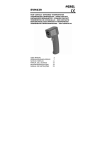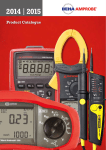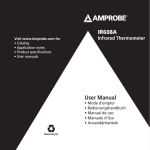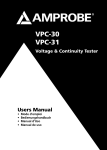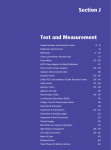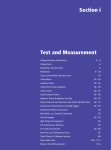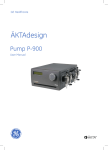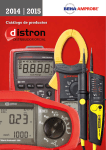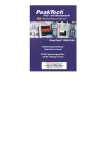Download MT-2000
Transcript
PAEBMT2000E0.qxd:PTDB2054-01.qxd MT-2000 Users Manual • Bedienungsanleitung • Istruzioni per l´uso 14.07.2009 1 PAEBMT2000E0.qxd:PTDB2054-01.qxd 14.07.2009 Symbolerklärung Warnung vor einer Gefahrenstelle. Bedienungsanleitung beachten. Vorsicht! Gefährliche Spannung, Gefahr des elektrischen Schlages. Durchgängige doppelte oder verstärkte Isolierung entsprechend Schutzklasse II IEC 61140. Kennzeichnung elektrischer und elektronischer Geräte (WEEE Richtlinie 2002/96/EG). Konformitätszeichen, bestätigt die Einhaltung der gültigen Richtlinien. Die EMVRichtlinie (89/336/EWG) werden eingehalten. Die Niederspannungsrichtlinie (73/23/ EWG) wird ebenfalls eingehalten. Einleitung: Der berührungslose Spannungsprüfer MT-2000 ist für die Spannungsprüfung an isolierten Kabel und Lei-tungen entwickelt worden. Dabei ist eine elektrische Verbindung zum Prüfling nicht erforderlich. Eine zweite Verbin-dung, z.B. zu Neutralleiter oder Erde ist nicht erforderlich. Die zweite Funktion des Gerätes ist eine Magnetfeldererkennung z.B. von Relais, Schützen und Magnetventilen. Der MT-2000 ist wartungsfrei, schutzisoliert und wird mit zwei handelsüblichen Micro Batterien 1,5V IEC LR03 versorgt. Leistungsmerkmale: • Berührungslose Spannungsprüfung 50V...600V AC • Anzeige mittels Leuchtdiode (blinkend) Akustisches Tonsignal (pulsierend) • Berührungsloses Prüfen von Wechselspannungen an isolierten Kabel und Leitungen • Auffinden von Leitungsunterbrechungen in isolierten Kabel und Leitungen 2 1 PAEBMT2000E0.qxd:PTDB2054-01.qxd 14.07.2009 • Magnetfelderkennung von Relais, Schützen und Magnetventilen • Phasenprüfer an Steckdosen • Handelsübliche 1,5V Batterien (Micro) Sicherheitsmaßnahmen Das Gerät hat unser Werk in sicherheitstechnisch einwandfreiem Zustand verlassen. Um diesen Zustand zu erhalten, muß der Anwender die Sicherheitshinweise in dieser Anleitung beachten. Die Bedienungsanleitung enthält Informatio-nen und Hinweise, die zu einer sicheren Bedienung und Nutzung des Gerätes notwendig sind. Vor der Verwendung des Gerätes ist die Bedienungsanleitung aufmerksam zu lesen und in allen Punkten zu verstehen und zu befolgen. Wird die Anleitung nicht beachtet oder sollten Sie es versäumen, die Warnungen und Hinweise zu beachten, können ernste oder lebensgefährliche Verletzungen bzw. Beschädigungen des Gerätes eintreten. Bei Spannungsmessungen jeder Art darf das Gerät nur am Handgriff angefaßt werden. Eine einwandfreie Funktion ist nur innerhalb dem in den technischen Daten angegebenen Temperaturbereich gewährleistet Vor jeder Benutzung muß das Gerät auf einwandfreie Funktion (z.B. an einer bekannten Stromquelle) geprüft werden. Vor dem Öffnen (z.B. für Batteriewechsel) muß das Gerät von allen Stromkreisen getrennt werden. Das Gerät darf von unbefugten Personen nicht geöffnet oder zerlegt werden. 3 1 PAEBMT2000E0.qxd:PTDB2054-01.qxd 14.07.2009 Bestimmungsgemäße Verwendung Das Gerät darf nur unter den Bedingungen und für die Zwecke eingesetzt werden, für die es konstruiert wurde. Hierzu sind besonders die Sicher-heitshinweise, die Technischen Daten mit den Umgebungsbedingungen und die Verwendung in trockener Umgebung zu beachten. Anzeige und Bedienelemente: 1) Prüfspitze 2) LED für Spannungsanzeige 3) Batteriefachdeckel 4) Magnetsensor und LED-Anzeige 3 4 2 1 4 1 PAEBMT2000E0.qxd:PTDB2054-01.qxd 14.07.2009 Durchführen von Wechselspannungsprüfungen: Um einen elektrischen Schlag zu vermeiden, sind unbedingt die geltenden Sicherheitsund VDE-Bestimmungen bezüglich zu hoher Berührungsspan-nung zu beachten, wenn mit Span-nungen größer 120V (60V) oder 50V (25V) eff AC gearbeitet wird. Die Werte in Klammern gelten für eingeschränkte Bereiche (wie z.B. Medizin, Landwirt-schaft). Der Spannungsprüfer ist für Wechsel-spannungen zwischen 50V und 600V AC.Eine einwandfreie Funktion ist nur im Temperaturbereich von 0...40°C <80% Feuchte. Das Signal bei der Spannungsprüfung lassen keinerlei Aussagen über Art und Höhe der anliegenden Spannung zu. Messen Sie im Zweifelsfall mit einem anzeigenden Meßgerät. Der Voltfinger ist bei eingelegten Batterien sofort betriebsbereit. Die blinkende LED und der pulsierende Signalton sagen aus, daß eine Spannung zwischen 50V und 600V AC mit einer Frequenz zwischen 50 und 500Hz erkannt wurde. Bei der Prüfung von Netzanschlußkabel auf Unterbrechung ist zu beachten, daß beide Leitungen einmal an die Phase (L) angeschlossen werden (Schukostecker um 180° drehen). 5 1 PAEBMT2000E0.qxd:PTDB2054-01.qxd 14.07.2009 Anwendungsbeispiele "Indirekte Spannungsprüfung": Spannungsprüfung ohne abisolieren Auffinden von Leitungsunterbrechung z.B. Kabeltrommel usw. " Phasenfinder an Steck- und Abzweigdosen Magnetfelderkennung Für die Magnetfelderkennung muß das Gerät umgedreht verwendet werden. Magnetfelderkennung z.B. Relais, Schütze und Magentventile usw. Der gekennzeichnete Punkt markiert die empfindlichste Stelle des Magnetsensor. 6 1 PAEBMT2000E0.qxd:PTDB2054-01.qxd 14.07.2009 Wartung Das Gerät benötigt bei einem Betrieb gemäß der Bedienungsanleitung keine besondere Wartung. Reinigung Sollte das Gerät durch den täglichen Gebrauch schmutzig geworden sein, kann das Gerät mit einem feuchten Tuch und etwas milden Haushaltsreiniger gereinigt werden.Verwenden Sie niemals scharfe Reiniger oder Lösungsmittel. Batteriewechsel 1) Die Batteriekappe (3) öffnen 2) Die alten Batterien durch neue ersetzen, dabei Polarität beachten! 3) Batteriekappe vorsichtig aufdrücken bis zur Einrastung. Batteriedeckel schließen Wird das Gerät über einen längeren Zeitraum nicht benutzt, muß die Batterie entnommen werden. Sollte es zu einer Verunreinigung des Gerätes durch ausgelaufene Batterien gekommen sein, muß das Gerät zur Reinigung und Überprüfung ins Werk eingesandt werden. 7 1 PAEBMT2000E0.qxd:PTDB2054-01.qxd 14.07.2009 Bitte denken Sie an dieser Stelle auch an unsere Umwelt. Werfen Sie verbrauchte Batterien nicht in den normalen Hausmüll, sondern geben Sie die Batterien bei Sondermülldeponien ab. Es müssen die jeweils gültigen Bestimmungen bzgl. der Rücknahme, Verwertung und Beseitigung von gebrauchten Batterien und Akkumulatoren beachtet werden. Technische Daten (gültig für 23°C ±5°C, < 80% rel. Luftfeuchte) Spannungsbereich: 50V...600V AC Frequenzbereich: 50Hz...500Hz Anzeige: Optisch, blinkender LED und Signalton pulsierend Schutzart: IP40 Temperaturbereich: 0°C...40°C <80% Feuchte Überspannungskat.: CAT III/600V gegen Erde Verschmutzungsgrad: 2 Meereshöhe: bis 2000m Stromversorgung: 2 x 1,5V (Micro) IEC LR03 Maße: 140 x 25 x 21 mm Gewicht: ca. 50 g 24 Monate Garantie Die Geräte unterliegen einer strengen Qualitätskontrolle. Sollten während der täglichen Praxis dennoch Fehler in der Funktion auftreten, gewähren wir eine Garantie von 24 Monaten (nur gültig mit Rechnung). Fabrikations- oder Materialfehler werden von uns kostenlos beseitigt sofern das Gerät ohne Fremdeinwirkung Funktionsstörun-gen zeigt und ungeöffnet an uns zurückgesandt wird. Beschädigungen durch Sturz oder falsche Handhabung sind vom Garantieanspruch ausgeschlossen. Treten nach Ablauf der Garantiezeit Funktions-fehler auf, wird unser Werksservice Ihr Gerät unverzüglich wieder instandsetzen. Änderungen vorbehalten! 8 1 PAEBMT2000E0.qxd:PTDB2054-01.qxd MAGNO VOLTfix Users Manual • Bedienungsanleitung • Istruzioni per l´uso 14.07.2009 1 PAEBMT2000E0.qxd:PTDB2054-01.qxd 14.07.2009 References marked on instrument or in instruction manual Warning of a potential danger, comply with instruction manual. Caution! Dangerous voltage. Danger of electrical shock. Continuous double or reinforced insulation complies with category II IEC 61140. Symbol for the marking of electrical and electronic equipment (WEEE Directive 2002/96/EC). Conformity symbol, the instrument complies with the valid directives. It complies with the EMV Directive (89/336/EEC), are fulfilled. It also complies with the Low Voltage Directive (73/23/EEC) is fulfilled. Introduction The contact-free voltage tester MT-2000 has been developed for voltage testing on insulated cables and conductors. For testing, no electrical connection to UUT is required. A second connection, e.g. to neutral or ground is not necessary. The second instrument function is the recognition of a magnetic field, e.g. of relays, contactors, and magnetic valves. The MT-2000 does not require maintenance. It is equipped with protective insulation. Power is supplied by means of two conventional micro batteries 1.5 V IEC LR03. 2 1 PAEBMT2000E0.qxd:PTDB2054-01.qxd 14.07.2009 Features • Contact-free voltage test 50 V...600 V AC • Display via LED (blinking) Acoustic sound signal (pulsating) • Contact-free testing of AC voltages on insulated cables and conductors • Locating line interruptions in insulated cables and conductors • Recognition of the magnetic field of relays, contactors, and magnetic valves • Phase tester of sockets • Conventional 1.5 V batteries IEC LR03 Safety Measures The instrument has left our factory in a safe and perfect condition. To maintain this condition, the user must pay attention to the safety references contained in this instruction manual. The instruction manual contains information and references, necessary for safe operation and maintenance of the instrument. Prior to using the instrument the user is kindly requested to thoroughly read the instruction manual and comply with it in all sections. Failure to read the instruction manual or to comply with the warnings and references contained herein can result in serious personal injury or damage to instrument. Only touch the instrument at handle surface provided. The instrument may only be used within the operating ranges specified in the technical data section. 3 1 PAEBMT2000E0.qxd:PTDB2054-01.qxd 14.07.2009 Before batteries are replaced the instrument must be disconnected from all live circuits. The instrument may only be opened by professionals. Appropriate Usage The instrument may only be used under those conditions and for those purposes for which it was developed. For this reason, particular attention must be paid to and instructions must be followed regarding the safety references the technical data - including environmental conditions and, usage in dry environments. If the instrument is modified or changed in any way its operational safety is no longer guaranteed. Display and Operation Elements 1) Test probe 2) LED for voltage indication 3) Battery case cover 4) Location for magnetic field indication 3 4 2 1 4 1 PAEBMT2000E0.qxd:PTDB2054-01.qxd 14.07.2009 Carrying out voltage measurement AC In order to avoid the danger of electrical shock, it is important that proper safety measures are respected when working with voltages exceeding 120V (60V) DC or 50V (25V) r.m.s. AC. These voltages represent internationally the limits of max. contact voltage. The voltage tester is appropriate for AC voltages between 50V and 600 V AC. A perfect instrument function is only ensured within a temperature range of 0 ... 40°C, >80 % humidity. The signal during the voltage test does not provide any indication of the type and level of voltage present. In case of doubt, measure the voltage by using a test instrument with display indication. After inserting the batteries, the Voltmagfinger is ready for operation. The blinking LED and the pulsating signal sound indicate that a voltage presence of a value between 50V and 600 V AC has been recognised, at a frequency of 50 to 500 Hz. When testing mains connecting cables for interruptions the user must ensure that both lines are connected once to phase (L). (Turn shockproof plugs by 180°). 5 1 PAEBMT2000E0.qxd:PTDB2054-01.qxd 14.07.2009 Working example "Indirect voltage testing": Voltage test at Insulated Locating line interruption conductorsl.e. cable drums etc. Working example " Direct voltage testing": Phase finding on socket aoutlets Recognition of a Magnetic Field To enable recognition of a magnetic field, the instrument has to be reversed Magnetic field recognition e.g. relays, Magnetfelderkennung z.B. Relais, Schütze und Magentventile usw. contactors and magnetic valve etc. Der Punkt Thisgekennzeichnete point is marking the markiert die empfindlichste location max. sensitivity Stelle des of Magnetsensor. for magnetic sensor.. 6 1 PAEBMT2000E0.qxd:PTDB2054-01.qxd 14.07.2009 Maintenance When using the instrument in compliance with the instruction manual, no special maintenance is required. Cleaning If the instrument is dirty after daily use, it is advised that it be cleaned using a damp cloth and a mild household detergent. Never use acid detergents or solvents for cleaning. Battery replacement 1) Press and push lightly to open. 2) Remove discharged batteries and insert new ones while respecting correct polarity. For battery type, please refer to the technical data section. 3) Carefully press battery case cover until latching. 4) Close battery cover If an instrument is not being used over an extended period of time, the batteries should be removed. If the instrument is contaminated by leaking batteries, the instrument should be returned to the factory for cleaning and inspection. Please consider your environment when you dispose of your batteries. They belong in a rubbish dump for hazardous waste. In most cases, the bat- 7 1 PAEBMT2000E0.qxd:PTDB2054-01.qxd 14.07.2009 teries can be returned to their point of sale. Please, comply with the current regulations concerning the return, recycling and disposal of used batteries. Technical Data (for 23°C ±5°C, < 80% rel. humidity) Voltage range: 50...600V AC Frequency range: 50Hz...500Hz Display: Clear, omnidirectional flashing beacon IP-Protection: IP40 Overvoltage category: CAT III, 600V Pollution degree: 2 Altitude: up to 2000m Temperature range: 0°C up to 40°C Humidity: <80% Power supply: 2x 1,5V batt. IEC LR03 Dimensions: 140x25x21mm Weight: Approx.50g 24 Month Guarantee The instruments are subject to stringent quality controls. If, in the course of normal use, a fault should occur, it is covered by our 24 Month Guarantee (valid only with invoice). Faults in manufacture and materials will be rectified by us free of charge, provided the instrument has not been tampered with, and is returned to us unopened. Damage due to dropping, abuse or misuse is not covered by the guarantee. Our Service Department will promptly repair any faults that occur outside the guarantee period for a reasonable charge. We reserve the right to make technical alterations without notice. 8 1 PAEBMT2000E0.qxd:PTDB2054-01.qxd MAGNO VOLTfix Users Manual • Bedienungsanleitung • Istruzioni per l´uso 14.07.2009 1 PAEBMT2000E0.qxd:PTDB2054-01.qxd 14.07.2009 Descrizione dei simboli Avviso da punto di pericolo. Osservare le istruzioni d'uso. Prudenza! Tensione pericolosa, pericolo di folgorazione. Isolamento continuo doppio o rinforzato secondo classe di protezione II IEC 61140. Simbolo per la marcatura delle apparecchiature elettriche ed elettroniche (RAEE Direttiva 2002/96/EC). Marchio di conformità, conferma il rispetto delle direttive vigenti. La direttiva per la compatibilità elettromagnetica (89/336/CEE) vengono rispettate. La direttiva per basse tensioni (73/23/ CEE) viene rispettata anch'essa Introduzione Il voltometro di prossimità MT-2000 è stato sviluppato per la verifica della tensione a cavi e a conduzioni isolati: non è necessario un collegamento elettrico con il pezzo da collaudare. Inoltre non è necessario un secondo collegamento per es. con il conduttore neutro o a terra. La seconda funzione dell`apparecchio è di riconoscere i campi magnetici per es. relè, paratoie e valvole magnetiche. Il MT-2000 non ha bisogna di manutenzione, ha un isolamento di protezione e viene alimentato da due micro-batterie esistenti in commercio da 1,5V CEI LR03. 2 1 PAEBMT2000E0.qxd:PTDB2054-01.qxd 14.07.2009 Caratteristiche • Controllo tensione senza contatto 50V...600V AC. • Indicazione tramite diodo luminoso (lampeggiante) e segnale acustico (ad impulsi). • Verifica senza contatto di tensioni alternate in cavi e conduttori isolati • Localizzazione di interruzioni conduttori in cavi e conduttori isolati. • Riconoscimento di campi magnetici di relè, paratoie e valvole magnetiche. • Cercafase per prese di corrente • Micro-batterie esistenti in commercio da 1,5V Provvedimenti di sicurezza L'apparecchio è uscito dal nostro stabilimento in perfetto stato di funzionamento. Per mantenere tale stato, l'utilizzatore deve osservare le avvertenze di sicurezza contenute nelle presenti istruzioni. Le istruzioni d'uso contengono informazioni ed indicazioni necessarie per un comando ed un uso sicuro dell'apparecchio. Prima di usare l'apparecchio, leggere con premura le istruzioni d'uso e assicurarsi di averle comprese e di saperle rispettare. Se le istruzioni non vengono rispettate o se non vengono osservate le avvertenze e gli avvisi, possono venire causati infortuni seri o mortali o il danneggiamento dell'apparecchio. Durante qualsiasi tipo di misurazione della tensione, l'apparecchio deve essere afferrato esclusivamente per l'impugnatura. Un funzionamento regolare è garantito esclusivamente entro il campo di temperatura indicato nei dati tecnici. 3 1 PAEBMT2000E0.qxd:PTDB2054-01.qxd 14.07.2009 Prima di ogni uso, l'apparecchio deve essere controllato verificando che esso funzioni regolarmente (p.e. applicandolo ad una fonte di corrente conosciuta). Prima di aprire l'apparecchio (p.e. per il cambio delle batterie) esso deve essere staccato da ogni circuito elettrico. L'apparecchio non deve essere né aperto né smontato da personale non autorizzato Uso consentito: L'apparecchio deve essere usato solo nelle condizioni e per gli scopi per i quali è stato costruito. A tale riguardo sono da osservare in particolar modo le avvertenze di sicurezza, i dati tecnici con le condizioni ambientali e l'uso in luoghi asciutti. Display ed elementi di comando: 1) Punta di controllo metallica (punta giravite) 2) LED per l’indicazione della tensione 3) Coperchio del vano portabatterie 4) Riconoscimento di campi magnetici 3 4 2 1 4 1 PAEBMT2000E0.qxd:PTDB2054-01.qxd 14.07.2009 Esecuzione di controlli di tensione alternata Se si lavora su tensioni maggiori di 120 V (60 V) o di 50 V ( 25 V) effettivi a corrente alternata, per evitare una folgorazione devono essere osservate assolutamente le disposizioni vigenti in materia di sicurezza e VDE riguardo ad alta tensione di contatto. I valori fra parentesi valgono per aree limitate (come p.e. nel campo della medicina, nell’agricoltura). Il tester è stato progettato per tensioni alternate comprese fra 50 V e 600 V. Un funzionamento regolare è garantito esclusivamente in un campo di temperatura compreso fra 0...40°C con umidità <80%. Il segnale nella verifica della tensione non consentono di fare alcuna affermazione sul tipo e sull`intensità della tensione adiacente. Misuratela con uno strumento di misura apposito in caso di dubbio. Il Voltfinger è subito pronto per l`uso se le batterie sono inserite. Il LED lampeggia e ilsegnale acustico pulsante indicano che è stata riconosciuta una tensione tra 50V e 600V AC con una frequenza tra 50 e 500Hz. Per verificare l´interruzione del cavo di allacciamento alla rete bisogna considerare che entrambi i conduttori vengono collegati una volta alla fase (L) (girarela spina Schuko a 180°). 5 1 PAEBMT2000E0.qxd:PTDB2054-01.qxd 14.07.2009 Esempi di applicazione "Controllo indiretto della tensione": Controllo della tensione cavo p.e. in rulli portacavi Localizzazione di interruzioni senza dover spelare i fili Esempi di applicazione Controllo diretto della tensione": Cercafase in prese elettriche e derivazioni Riconoscimento di campi magnetici Esempi di applicazione Magnetfelderkennung Relais, Schütze di Riconoscimento diz.B. campi magnetici und relè,Magentventile paratoie e usw. valvole magnetiche. Der gekennzeichnete Punkt markiert die empfindlichste Stelle des Magnetsensor. 6 1 PAEBMT2000E0.qxd:PTDB2054-01.qxd 14.07.2009 Manutenzione Se usato come indicato nelle istruzioni d'uso, l'apparecchio non richiede una particolare manutenzione. Pulizia Se durante l'uso quotidiano l'apparecchio di dovesse sporcare, esso può essere pulito con un panno umido e con del detergente domestico non aggressivo. Non usare mai detergenti aggressivi o solventi. Sostituzione della batteria 1) Aprire il coperchio della batteria (3) con un giravite o strumento simile. 2) Sostituire le batterie vecchie con delle batterie nuove, osservando la corretta polarità! Per il tipo di batteria vedere i dati tecnici. 3) Premere il coperchio della batteria sino a che si innesta. Chiudere il coperchio delle batterie 7 1 PAEBMT2000E0.qxd:PTDB2054-01.qxd 14.07.2009 Se l'apparecchio non viene usato per un periodo prolungato, la batteria deve essere estratta. Se l'apparecchio dovesse sporcarsi a causa della fuoriuscita del liquido della batteria, l'apparecchio deve essere spedito in stabilimento per essere pulito e controllato. Si prega di tenere in considerazione il lato ecologico di tali operazioni. Non gettate le batterie esauste nei rifiuti urbani, ma smaltitele nei contenitori previsti Sono da osservare le disposizioni generalmente valide riguardo al ritiro, al riciclaggio e allo smaltimento di batterie e di accumulatori esausti. Dati tecnici (valido per 23°C ±5°C, umidità relativa < 80%) Campo di tensione 50V...600V AC Campo di frequenza 50Hz...500Hz Indicazione Ottica con LED/lampada lampeggiante e tono acustico ad impulsi Tipo di protezione IP40 Campo di temperatura -0°C...40°C umid. rel. < 80% Categoria di sovratensione CAT III / 600 V verso terra Grado di imbrattamento 2 Altezza sul livello del mare sino a 2000 m Alimentazione di corrente 2 batterie da 1,5 V (Micro) IEC LR03 Dimensioni 140 x 25 x 21 mm Peso ca. 50 g 8 1 PAEBMT2000E0.qxd:PTDB2054-01.qxd 14.07.2009 Garanzia di 24 mesi Gli apparecchi vengono sottoposti ad un severo controllo di qualità. Se nonostante ciò durante l'uso quotidiano dovessero presentarsi errori di funzionamento, offriamo una garanzia di 24 mesi (valida solo insieme alla fattura). Gli errori di fabbricazione e di materiale vengono eliminati gratuitamente se l'apparecchio ci viene restituito integro senza segno di forzature e di tentativi di apertura. Danni causati da cadute o da errori di manipolazione sono esclusi dalla garanzia. Se al termine del periodo di garanzia si presentano errori di funzionamento, il nostro servizio di assistenza è a disposizione per la riparazione dell'apparecchio. 9 1 PAEBMT2000E0.qxd:PTDB2054-01.qxd 14.07.2009 Amprobe Test Tools BEHA-AMPROBE GmbH In den Engematten 14 79286 Glottertal Deutschland Tel.: +49 (0) 7684/8009-0 Fax: +49 (0) 7684/8009-410 E-Mail: [email protected] 07/2009 10 PAEBMT2000E0 1 PAEBMT2000E0.qxd:PTDB2054-01.qxd 14.07.2009 11 1 PAEBMT2000E0.qxd:PTDB2054-01.qxd Visit www.beha-amprobe.eu • Catalog • Appliction notes • Product specifications • User manual 14.07.2009 1































